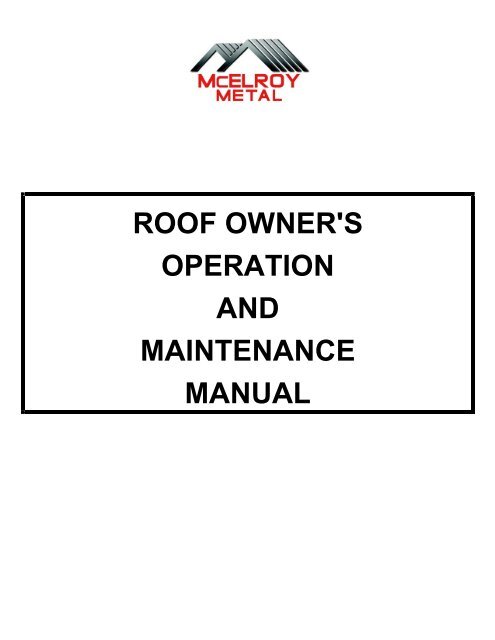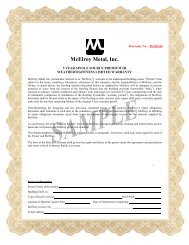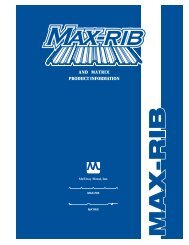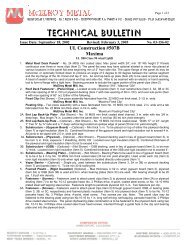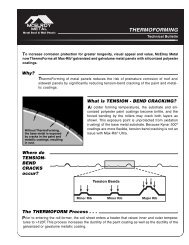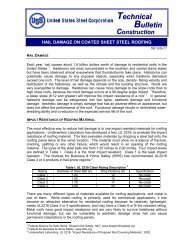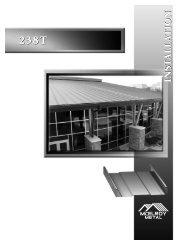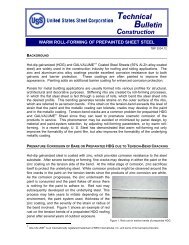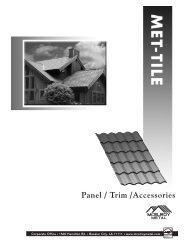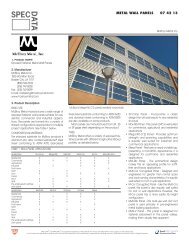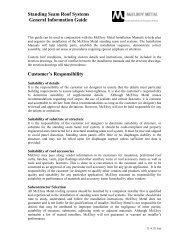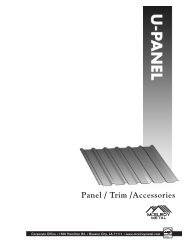Operation and Maintenance Manual - McElroy Metal
Operation and Maintenance Manual - McElroy Metal
Operation and Maintenance Manual - McElroy Metal
You also want an ePaper? Increase the reach of your titles
YUMPU automatically turns print PDFs into web optimized ePapers that Google loves.
Table of ContentsSection Title PageSection 1.0 General <strong>Maintenance</strong> Statement 2Section 2.0 Safety 2Section 3.0 Inspections 2- 4Section 4.0 Repairs 4Section 5.0 Foot Traffic 4Section 6.0 Drainage 4Section 7.0 Ice <strong>and</strong> Snow Removal 5Section 8.0 Additions to Roof 5Section 9.0 Dissimilar <strong>Metal</strong>s 5Section 10.0 Paint <strong>and</strong> Coating 51 | P age
Section 1.0 – General <strong>Maintenance</strong> StatementYour new <strong>McElroy</strong> <strong>Metal</strong> roof is designed to provide many years of protection with very little maintenance. However, thereis no roof that is immune to severe weather or that is completely maintenance free. To keep your roof performing as itshould, a comprehensive maintenance program should be implemented. This manual will inform you of things that need tobe accomplished in order to insure your roof is in good condition <strong>and</strong> that it will continue to meet your expectationsthrough the years.Section 2.0 - SafetySAFETY FIRST!!!Walking on a metal roof can be dangerous. Safety should always be your number one priority when walking on,inspecting, or performing maintenance on your <strong>McElroy</strong> <strong>Metal</strong> roof system. You should always use safety equipmentsuch as fall protection as required by OSHA <strong>and</strong> other regulatory agencies. Failure to do so could result in serious injuryincluding death. In addition, you may also be subject to citations for non-compliance.You should always use extreme caution when walking on metal roofs with steep slopes, near roof edges, or on roofs thatare wet or covered with ice or snow. You should insure that all personnel are trained in safety procedures <strong>and</strong> that allsafety equipment is in proper working condition.When walking on a metal roof, inspecting, or performing roof maintenance, always take the following precautions: Use fall protection <strong>and</strong> other safety equipment as required. Do not walk on roof flashings such as gutter, rake, hip or ridge flash. Do not walk on Light Transmitting Panels (LTP’s). Guard all LTP’s <strong>and</strong> roof openings. Step only in the panel flat directly on or in close proximity to a supporting roof structural.Section 3.0 – InspectionsYour <strong>McElroy</strong> <strong>Metal</strong> Roof should be inspected annually at a minimum, <strong>and</strong> whenever any of the following occur:o After a fire, v<strong>and</strong>alism or any known damage to the roof or an adjacent roof area.o After exposure to severe weather, including, but not limited to, high winds, hail, or abnormally heavy rains,ice or snow.• Items to check after high winds include: Debris scattered on the roof Loose flashing or other roof components Punctures from falling or flying objects Loose fasteners (Replace stripped-out fasteners by removing existing fastener; applybutyl sealant into hole; install an oversize, long-life fastener into hole) Any other damage2 | P age
Section 3.0 – Inspections (Cont.)• Items to check after a hail storm include: Punctures Damaged trim Loose fasteners (Replace stripped-out fasteners by removing existing fastener; applybutyl sealant into hole; install an oversize, long-life fastener into hole) Any other damage• Items to check after abnormally heavy rains include: Roof for ponding water Gutters for ponding water Roof curbs <strong>and</strong> penetrations <strong>and</strong> other special trim conditions to ensure water is notponding upslope from these areas Loose fasteners (Replace stripped-out fasteners by removing existing fastener; applybutyl sealant into hole; install an oversize, long-life fastener into hole) Any other damage• Items to check after ice or snow events include: Check trim <strong>and</strong> plumbing pipes for damage from sliding ice or snow Roof for ponding water Roof curbs <strong>and</strong> penetrations <strong>and</strong> other special trim conditions to ensure water is notponding upslope form these areas Damage to gutters from sliding ice or snow Damage to snow retention devices Loose fasteners (Replace stripped-out fasteners by removing existing fastener; applybutyl sealant into hole; install an oversize, long-life fastener into hole) Any other damageoAfter other trades have been on the roof for any reason;• Inspect the roof for damage caused by workers including chemical or solvent spills, scratches inthe paint or Galvalume coating, excessive foot traffic <strong>and</strong> punctures.• Make sure that any debris or scrap left behind by the workers is removed from the roofimmediately.• Avoid using cutoff saws <strong>and</strong> welding equipment over the roof. In cases where this is not possible,the roof must be adequately protected. A fire cloth is recommended.• Items such as drill shavings, wire, metal scrap <strong>and</strong> other debris can corrode <strong>and</strong> damage the roof.Sharp pieces of metal, such as those left by a nibbler, can stick in a worker's shoes <strong>and</strong> scratchthe paint as they walk on the roof.• Mortar or concrete will etch the paint or Galvalume coating. Roof panels in areas where there is apossibility of any masonry product being spilled on them should be protected. In the event that thepanels do have a masonry product spilled on them, they should be cleaned <strong>and</strong> the panelsrinsed.3 | P age
Section 7.0 – Ice <strong>and</strong> Snow RemovalExcessive ice <strong>and</strong> snow should be removed from the roof immediately to prevent damage to roof <strong>and</strong> possible collapse.Do not use metal tools to remove the ice or snow as this can damage the paint <strong>and</strong>/or Galvalume coatings. Also, becareful around plumbing pipes <strong>and</strong> flashings.Be extremely careful if your roof has Light Transmitting Panels. THESE PANELS WILL NOT SUPPORT A PERSON'SWEIGHT AND WILL BE DIFFICULT OR IMPOSSIBLE TO SEE IF THEY ARE COVERED WITH ICE AND SNOW.Section 8.0 – Additions to RoofAll additions to the roof, including but not limited to, roof curbs, pipe penetrations <strong>and</strong> HVAC units must be approved inwriting by <strong>McElroy</strong> <strong>Metal</strong> before work commences. All work must be performed by a <strong>McElroy</strong> <strong>Metal</strong> "Certified Installer".Section 9.0 – Dissimilar MaterialsNever allow your roof to come in contact with, or water runoff from, any dissimilar metal including but not limited to: copper lead graphite mortar or cementFailure to adhere to this requirement will cause your roof to rapidly deteriorate due to galvanic corrosion <strong>and</strong> will void allwarranties. Common abuses of this requirement include: lead hats for plumbing vents, copper lightning rods <strong>and</strong>/or cable,copper trim, existing copper gutter that drains water onto your new roof, <strong>and</strong> condensate from rooftop AC units drainingonto roof.Section 10.0 – Paint <strong>and</strong> CoatingRemove smudge marks from bare Galvalume. Formula 409 has proven to be somewhat effective. Lightly rub with aclean cloth <strong>and</strong> rinse with water. Do not rub more than required to remove smudge. No product will remove all smudgemarks.Remove rust stains. Soft Scrub has proven to be somewhat effective. Lightly rub with a soft cloth <strong>and</strong> rinse with water.Do not rub more than required to remove stain. No product will completely remove rust stains.To touch-up scratches in paint (not to bare metal), clean area to be painted with mineral spirits. Rinse thoroughly <strong>and</strong> dry.Using a small artist's brush, lightly apply the absolute minimum amount of touch-up paint required to fill the scratch. Useonly touch-up paint supplied by manufacturer.5 | P age


